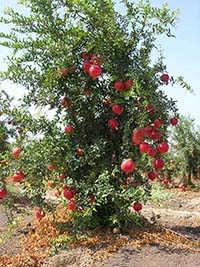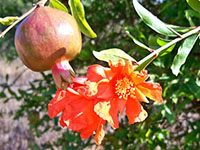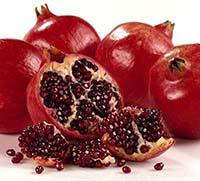Tibetan: སེ་འབྲུ
Pronunciation: sedru
Botanical name: Punica granatum

Pomegranate tree
Other names: སེ་ལ་ཤརྟུ (Wyl: se la shartu), མཆིན་ནད་ཀྱི་དགྲ (Wyl: mchin nad kyi dgra, lit. «enemy of liver diseases»), ཌཱ་ཌི་མ (Wyl: DA Di ma), ཕ་ལ་ཏ་ཀ (Wyl: pha la ta ka), མ་ཧུ་ར (Wyl: ma hu ra), ཕོ་བའི་གཉེན (Wyl: pho ba’i gnyen, lit. «friend of stomach»), རྐེད་མ (Wyl: rked ma), སྤྲེའུ་ཤིང (Wyl: spre’u shing, lit. «monkey tree»), མཛོད་ལྡན (Wyl: mdzod ldan, lit. «treasury»), ལོ་ཐོག་གཤེད (Wyl: lo thog gshed), ཤིང་ཏོག་སྐྱུར་མོ (Wyl: shing tog skyur mo, lit. «sour fruit»).

Pomegranate flower
Class of materia medica: medicinal trees ཤིང་སྨན་སྡེ (Wyl: shing sman sde).
Part used: The pomegranate fruits
Period of collection: The fruits are collected in October-November after their maturation.
Method of processing: Juicy edible seeds are taken out, dried in the sun and then used.
Taste: sour to sweet
Potency: warm to oily

Pomegranate fruit and
fresh seeds
Medicinal uses: it restores metabolic heat (me drod), corrects loss of appetite, eliminates all kinds of stomach diseases, stops cold natured diarrhea. The pomegranate is known as “king of hot medicines” and it is used for all forms of cold diseases and rLung (rlung) disorders of the lungs.
1) དགའ་བའི་རྡོ་རྗེ “འཁྲུངས་དཔེ་དྲི་མེད་ཤེལ་གྱི་མི་ལོང་།” མི་རིག་དཔེ་སྐྲུན་ཁང 1995 pp. 455 ill ISBN 7-105-02414-3 (Tibetan) Modern introduction to raw materials used in Tibetan medicine.
2) དེའུ་དམར་དགེ་བཤེས་བསྟན་འཛན་ཕུན་ཚོགས “ཤེལ་གོང་ཤེལ་ཕྲེང་།” བོད་གཞུང་སྨན་རྩིས་ཁང 1994 pp. 537 Classical introduction to raw materials used in Tibetan medicine written by Deumar Tenzin Puntsok.
3) Dawa Gyalpo “A Clear Mirror of Tibetan Medicinal Plants” Men-tsee-khang 1999 Vol. 1 pp. 375, ill ISBN-10: 1122692323 (English).
4) བོད་ལྗོངས་སྨན་རྩིས་ཁང་གསོ་རིག་ཞིབ་འཇུག་ཁང་གི་ཁོངས་མི “ཀྲུང་ཧྭ་སྔོ་འབུམ་བོད་ལུགས་སྨན་རྫས” ཀྲུང་གོའི་བོད་རིག་པ་དཔེ་སྐྲུན་ཁང 2007 pp.898 ISBN: 978-7-80057-952-3 (Tibetan).

